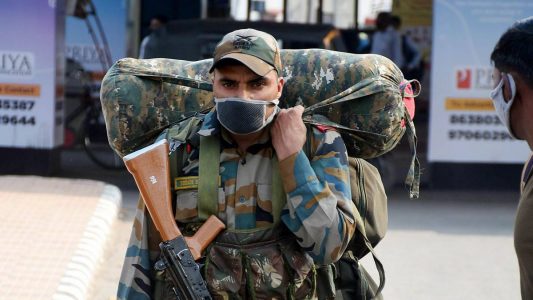
Terrorists can weaponise the coronavirus
With India sitting on the cusp of stage 3 — community transmission — of the coronavirus pandemic, the armed forces face three major challenges. To control the spread of the virus among its personnel in order to maintain operational preparedness.
To prevent the terrorists in Jammu and Kashmir from using Covid-19 as a biological weapon to target the military and the population, and exploit the situation to step up insurgency. And to assist the government in fighting the scourge if the pandemic reaches stage 3 and 4.
Military is known for its high standards of hygiene and sanitation, and health care. However, its living and functional environment also creates serious vulnerabilities. Troops live in barracks with common toilets and bathing areas. They dine in community messes. Functionally, during training and operations, they operate in close proximity to each other. Hence, the military simply cannot afford to allow Covid-19 to penetrate its environment as it is difficult to practice social distancing there. History is replete with examples where contagious diseases have caused more casualties than actual fighting.
The military, thus, has no option but to cocoon itself. Apart from isolating the cantonments, military stations, air and naval bases, decongestion of barracks must take place, and part of the troops must be moved to tented camps or prefabricated shelters. Soldiers and families living in civilian areas must be moved inside the military stations into temporary accommodations. Those going on leave should be stopped and those already on leave should either get extension or be put under quarantine on return.
The armed forces have already taken a slew of measures to reduce congestion and access to military bases. The timely precautions have been very successful. So far, only one confirmed case has been reported.
War and conflict do not wait for epidemics to end. In fact, the adversaries exploit such situations. The Naxal ambush in Sukma that killed 17 and injured 15 security personnel on 21 March 2020 is a case in point.
Terrorists are always looking for opportunities to cause mass destruction. The outbreak of Covid-19 presents them with one such opportunity. In fact, internet rumours attribute the origin of Covid-19 to Wuhan Institute of Virology, a military laboratory dedicated to the study of deadly pathogens. Rumours aside, terrorists can engineer spread of the virus through infected civilians/terrorists among the population and pin the blame on the security forces.
The Army can also be targeted through infected porters/labourers working at military bases and on the posts on the Line of Control, where congestion is acute. Security forces with the help of the administration have to protect the population and also safeguard themselves.
Terrorists would also try and exploit the anti Covid-19 precautions of the Army, which focus on self-imposed quarantine/isolation, to step up the infiltration across the Line of Control and operations in the hinterland. The Army has no choice but to take precautions and continue to maintain the tempo of counter-terrorist operations. If necessary, the soldiers must use of chemical/biological protective suits.
With effect from 31 January, 2020, if not earlier, when the first Covid-19 case was reported in India, the armed forces would have put into effect detailed plans to safeguard themselves and to assist the government. The armed forces plan for the worst case scenario and logically would have already prepared its response for the community transmission and epidemic stages. It came as no surprise that the quarantine centre at Manesar was constructed in 48 hours. Since then, 14 more facilities have been established. The Indian Air Force has brought home 1,059 stranded citizens from across the world.
Indian Armed Forces have 1.5 million trained manpower located across the length and breadth of the country. Outside a few select government/private institutions, the military has the best medicare infrastructure. It has approximately 13,000 officers (doctors/specialists/nursing officers) and 1 lakh medical support staff. Two thirds personnel can be committed for the national effort while one third man the essential in-house requirements. Retired officers and medical personnel can nearly double the existing resources.
The armed forces have 130 hospitals. In addition, another 100 field hospitals can be created. With the help of private doctors and medical students, many more temporary facilities can be made operational in a short span of time. These resources can be complemented with the government medicare infrastructure.
Military engineers can convert requisitioned buildings/sheds/factories into hospitals and also construct new ones using prefabricated material. All that the armed forces will require will be funds, ICU equipment, ventilators, medicines and other essential equipment.
In the third and fourth stage of an epidemic, the scale of infected population overwhelms the resources. The armed forces can help in enforcement of isolation. Supply chain of essential commodities get affected. The worst-affected are the ‘have nots’. This will result in serious law and order problems where the armed forces will have to assist the civil authorities, both to deliver supplies and to control the lawlessness.
As per my assessment, we will be in the thick of stage 3 in one month’s time. The 21-day lockdown has given us time for quickly increasing the testing facilities, personal protective equipment, isolation beds, ICU beds, ventilators and other essential equipment.
The government in consultation with the armed forces must plan to seamlessly superimpose the military resources on the existing civilian infrastructure. Piecemeal requisitioning of the military resources will be counter-productive.
Hundred years ago in 1918-1919 the colonial Indian Army soldiers returning from the First World War brought the Spanish Flu to India, which resulted in 18 million deaths. I have no doubt that a 100 years later, the armed forces of India will assist the government in managing the Covid-19 pandemic with minimum losses.
Source: The Print





